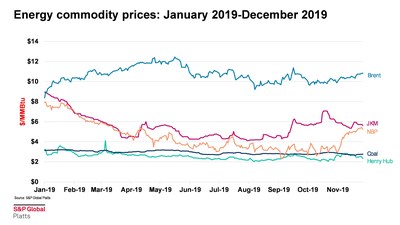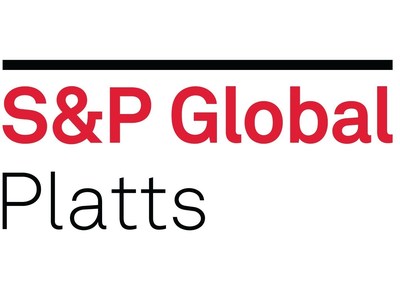Press Releases
NEW YORK, Dec. 11, 2019 /PRNewswire/ -- Analysts at S&P Global Platts, the leading independent provider of information, analysis and benchmark prices for the commodities and energy markets, today released their 2020 outlook. The outlook presumes continued high geopolitical risks to oil supply, a slight recovery in oil demand driven by IMO 2020 low-sulfur, bunker-fuel specification changes, and it paints oil as the bright spot in an otherwise largely bearish energy outlook.

Chris Midgley, head of analytics, S&P Global Platts, said: "As the new decade begins, the first quarter may be a reprieve for an energy complex that is largely cascading towards a race to the bottom. For 2020 as a whole, energy prices will struggle to post any meaningful gains over 2019, and many fuels will see sizable price declines. However, oil prices are likely to turn in the strongest pricing performance in 2020, benefitting from the uptick in demand from IMO 2020 and the commitment from OPEC to restrain supply."
DEMAND FACTORS
The new forecasts from S&P Global Analytics point to global oil demand growth accelerating to 1.26 million barrels per day (MMB/D) in 2020, up from 0.95 MMB/D growth in 2019, with growth expected in all regions except Western Europe and Japan. About 20% of that projected growth in oil demand is associated with the IMO bunker-fuel specification change, which will push high-sulfur fuel oil, no longer allowed for use in maritime shipping, into power generation, requiring more middle distillates and low-sulfur fuel oil to satisfy demand in the shipping sector.
Demand growth will be increasingly reliant on emerging economies and led by distillates in 2020. Jet fuel demand is forecast to rise by 140,000 b/d. In addition, it may benefit from the return of the 737 Max airline fleet, which curtailed airline demand by as much as 1% in 2019.
Weather is set to become more prominent in setting energy demand: Despite a rosier outlook for the global economy, supported by a weaker dollar and more constructive trade talks, weather will have a greater impact on energy commodity demand. Heating and cooling can swing demand significantly as total global energy consumption grows, and agriculture cycles (monsoons, flooding, and drought) affect harvests and climate events (hurricanes and typhoons) affect economic activity.
OIL PRICES
Low oil inventories, deeper OPEC-plus output cuts and IMO 2020 will see crude oil prices rise in early 2020, with the price influence of IMO 2020 expected to peak in March-May. This strength will likely enable Brent to break above $65/barrel, before falling back to the low $60s/barrel by end-2020 as IMO support fades. West Texas Intermediate (WTI) crude will likely break through $60/barrel in early 2020, before dropping back to the high-$50s/barrel.
The impact of IMO 2020 will favor sweet crudes (such as WTI and Brent). This will result in Dubai sour crude trading at a premium, squeezing Asian refinery margins and narrowing the Brent-Dubai spread.
Overall refinery margins will strengthen in 2020, driven by strong gasoil prices due to enhanced demand for distillates. However, Asian simple-refinery margins will be negative, reducing exports of gasoil to the West and tightening European inventories. This will require stronger simple-refinery margins in Europe to balance demand. The overbuild of refinery capacity in Asia and trend towards crude-to-chemicals refineries will ultimately narrow Asian refinery and petrochemicals margins as the current golden age of refining comes to an end in 2020.
GEOPOLITICAL FACTORS
Geopolitical risks to oil supply will remain elevated in 2020, as both the US and Iran continue their maximum pressure campaigns. Sanctions relief looks unlikely before the November 2020 US presidential election, although US sanctions policy has proven unpredictable. Libya, Iraq and Nigeria remain as identifiable downside production risk in 2020.
For the UK, the looming general election and its repercussions for Brexit remain a key risk, with implications for the UK's participation in the EU Emissions Trading Scheme and UK's overall carbon price.
The China/US trade war and the African Swine Fever crisis in Asia will continue to impact agriculture, the latter having a significant impact on soybean demand until it can be resolved. However, after three years of sugar supply and demand surpluses globally, the world is headed to a deficit of 6 million metric tons, putting sugar in the spotlight, and likely to drive ethanol prices higher.
US SHALE
US shale activity is slowing, as drillers retain a focus on capital discipline and full-cycle break-evens hover around $60 per barrel. Despite this, the US will again lead the world in oil production growth, growing by 1.3 MMB/D to 20.9 MMB/D. This will place domestic production above domestic consumption for the first in decades. However, the US will still be an importer of crude oil in 2020, while US exports of shale will jump 1.5 million barrels per day.
LNG, NATURAL GAS
The global liquefied natural gas (LNG) market will again see large volumes of supply added in 2020, mainly from the United States. S&P Global Platts Analytics forecasts an additional 32 billion cubic meters (bcm) of LNG supply in 2020, compared with an absolute liquefaction capacity increase of 40 bcm.
LNG demand in 1Q2020 will be the most important factor for global natural gas prices during 2020. If winter natural gas demand underwhelms as it did last year, LNG cargoes will be forced into Europe, where prices will again need to fall to levels to maximize coal-to-gas switching.
European gas prices will decline over much of 2020, with Dutch natural gas trading hub TTF prices averaging about $4.15/MMBtu and bottoming out at $2.75/MMBtu in the third quarter. This will be challenging to US LNG break-evens, and force a temporary underutilization of US liquefaction capacity this summer.
The benchmark JKM LNG price is forecast by S&P Global Platts Analytics to increase seasonally in the first quarter due to higher freight rates and a more normal winter demand profile. Platts Analytics sees JKM LNG prices falling a further 20%, to average just below $4.50/MMBTU in 2020, as new LNG supply pushes prices toward coal parity in Europe. Platts JKM prices will likely hit fresh lows in the 2nd quarter of below $3.50/MMBTU.
2020 will be a landmark year for the US natural gas market because of a surge in LNG exports and related feedstock demand, which will push demand growth higher than supply growth. However, Henry Hub (HH) will not benefit from this structural shift. S&P Global Platts Analytics sees HH natural gas prices averaging $2.42/MMBTU in 2020, down from 2019. On top of excess supply, which has pushed storage levels above the five-year average, the price of HH natural gas will be forced to stay in a range that will support a continual rise in the dispatch of US LNG cargoes. The The US is expected to add another 28 billion cubic meters per year of LNG export capacity, through the completion of facilities.
In Europe, negotiations between Russia and Ukraine over a new gas transit agreement are keeping prompt TTF prices at higher levels, which do not necessarily reflect the underlying supply/demand fundamentals. A deal is looking more likely, given talks commencing between President Putin and President Zelensky. Furthermore, Ukraine has agreed that Gazprom can repay its arbitration debt through the supply of gas, easing tensions around repayment.
RENEWABLES
Electric vehicle (EV) sales and renewable installations are poised to bounce back from a sluggish 2019. Solar PV additions are expected to rise about 3% to 96 gigawatts in 2020. Western European markets are forecast to see combined wind and solar generation growth of about 10% in 2020, with Spain in particular seeing robust capacity gains on positive policy incentives. Cost declines will continue to make these technologies more cost competitive and policy measures will incentivize growth. However, the increasing demand for metals (including nickel, cobalt and lithium for batteries) and the associated energy demand and impact of mining and manufacturing may open up new environmental, social and governance (ESG) concerns.
Hydrogen usage and flexibility will be center-stage during the Tokyo Olympics where the fuel will be used to both power vehicles for the games, as well as power the Olympic Village. In addition, Germany, UK, and the Netherlands continue to advance research and pilot projects for hydrogen power storage applications, and increasingly seek to inject hydrogen into the natural gas grid to help integrate renewables and decarbonize key sectors.
Chris Midgley, head of analytics, S&P Global Platts: "With the spotlight being increasingly put on the impacts of climate change as highlighted by Greta Thunberg and the Climate Extinction rebellion, lower energy prices threaten to continue to drive increased demand for energy and challenge the economics for alternative energies and transportation. Efforts by governments to increase energy prices to support the climate agenda will continue to be met by equal opposition as seen with the gilets jaunes and protests in Chile, Ecuador and Iran. As we step in to the next decade, we arrive at an intriguing crossroad for the energy transition, which will be shaped by regulation, technology and consumer sentiment. The paths we choose will shape the future for generations to come."
Media Contact:
Americas: Kathleen Tanzy, + 1 917-331-4607, kathleen.tanzy@spglobal.com
About S&P Global Platts
At S&P Global Platts, we provide the insights; you make better-informed trading and business decisions with confidence. We're the leading independent provider of information and benchmark prices for the commodities and energy markets. Customers in over 150 countries look to our expertise in news, pricing and analytics to deliver greater transparency and efficiency to markets. S&P Global Platts coverage includes oil and gas, power, petrochemicals, metals, agriculture and shipping.
S&P Global Platts is a division of S&P Global (NYSE: SPGI), which provides essential intelligence for companies, governments and individuals to make decisions with confidence. For more information, visit http://spglobal.com/platts

SOURCE S&P Global Platts
